Two main directions of my research are:
- Asymptotic analysis of integrable stochastic systems through exact formulas and algebraic techniques.
- Development of robust methods for proving the universality of the known asymptotic behaviors.
The list of my publications is available at Google Scholar Citations, arXiv, and below.
Keywords: 2d statistical mechanics, random matrices, interacting particle systems, asymptotic representation theory.
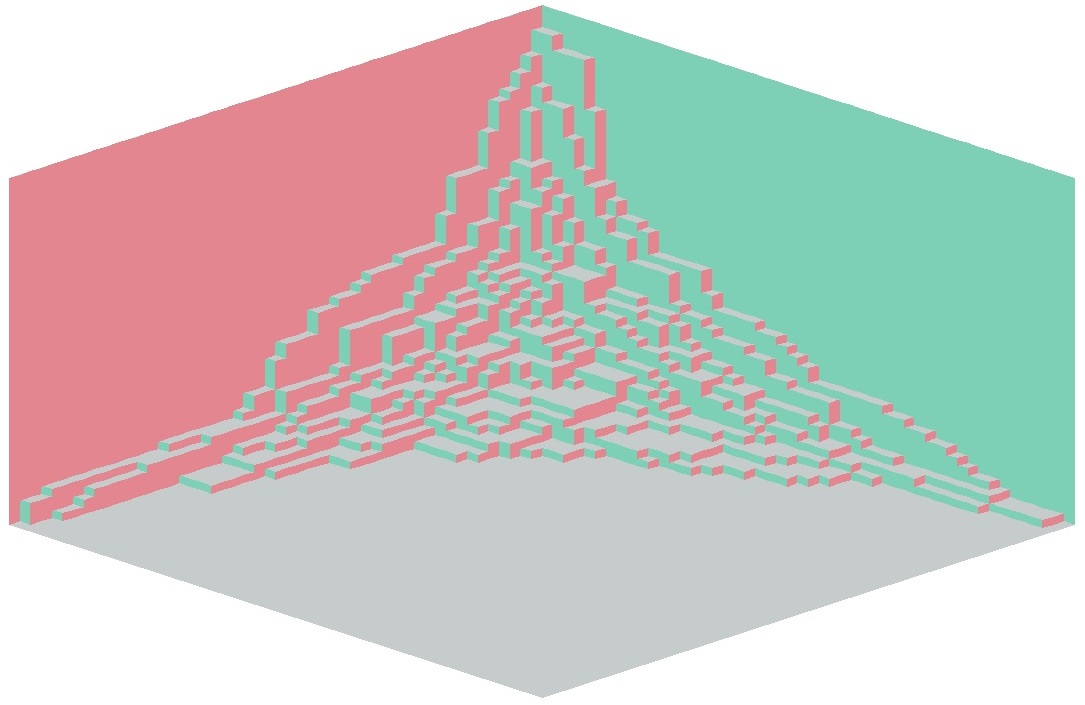 |
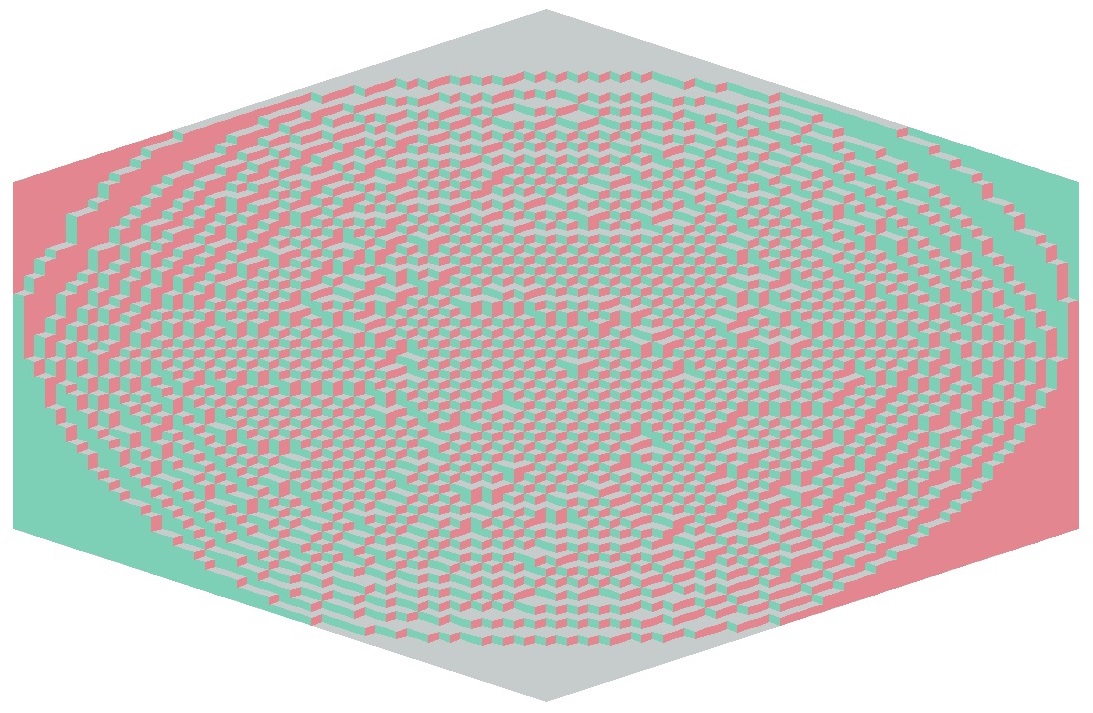 |
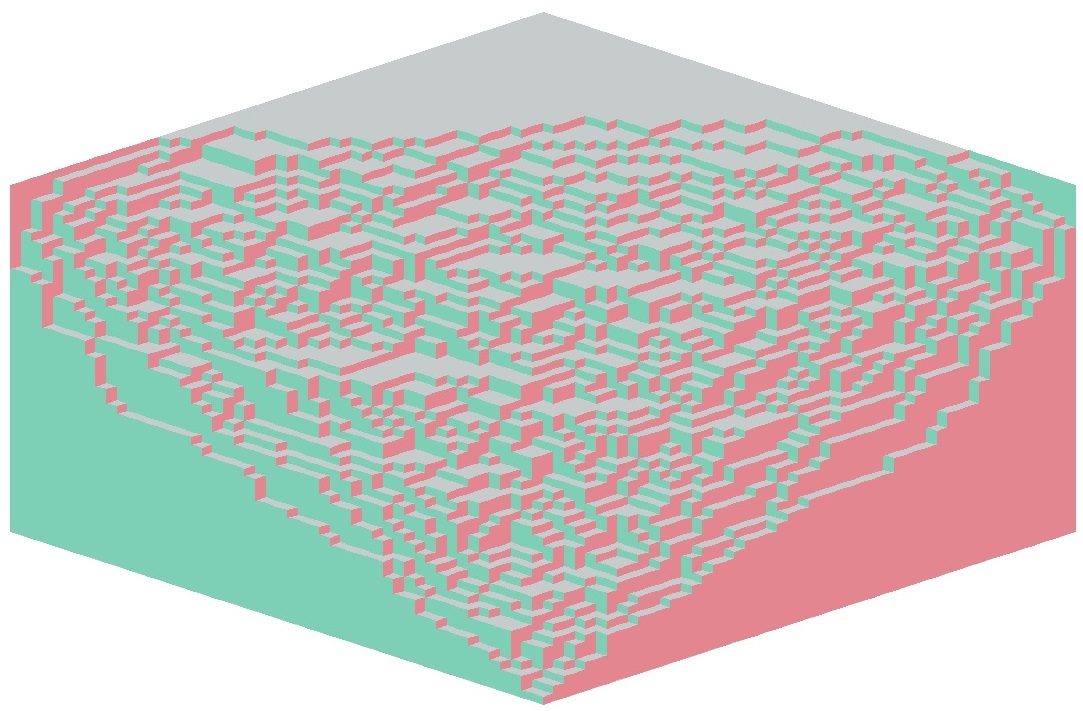 |
| |
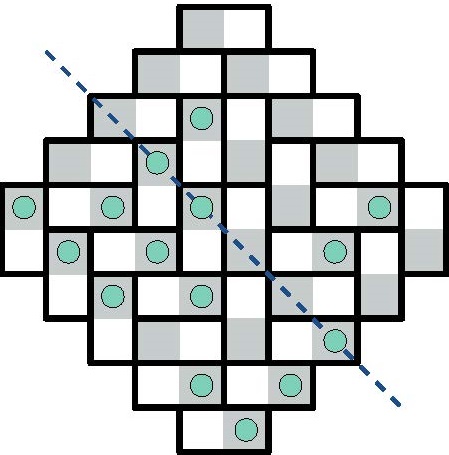 |
|
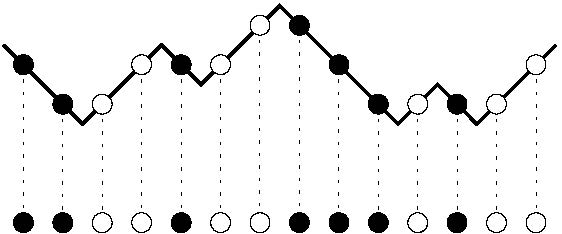 |
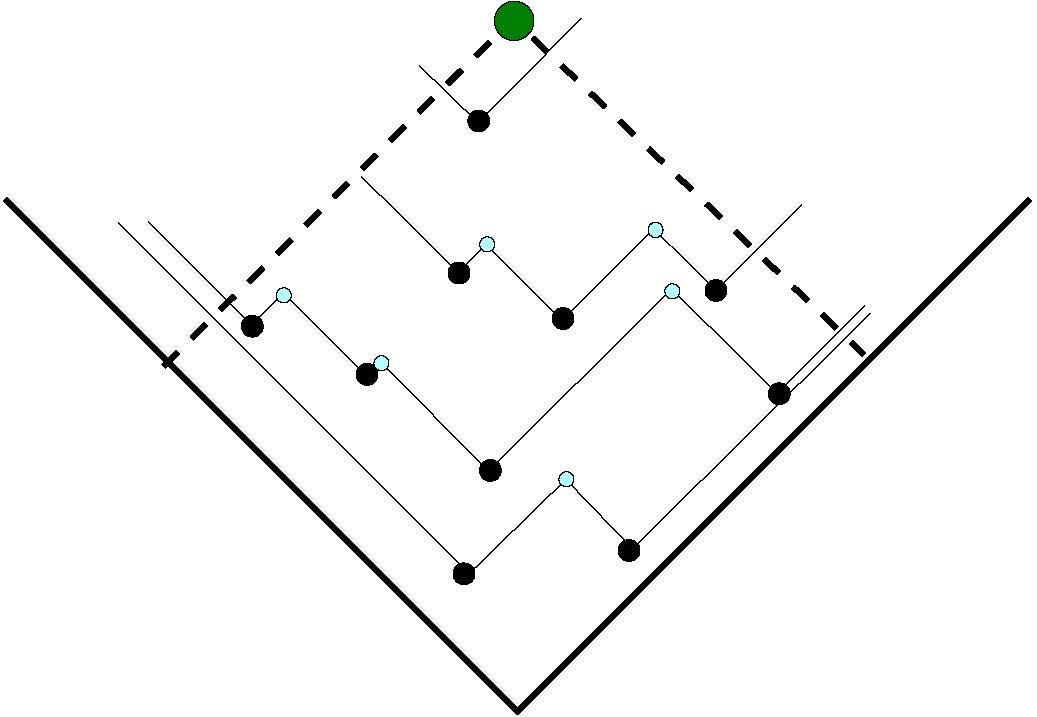 |
Articles in chronological order (point at a title to see the abstract):
- Non-intersecting paths and Hahn orthogonal polynomial ensemble, We compute the bulk limit of the correlation functions for the uniform measure on lozenge tilings of a hexagon. The limiting determinantal process is a translation invariant extension of the discrete sine process, which also describes the ergodic Gibbs measure of an appropriate slope. Functional Analysis and its Applications , 42 (3) (2008), 180-197, arXiv:0708.2349
- Shuffling algorithm for boxed plane
partitions (joint paper with A.Borodin),
We introduce discrete time Markov chains that preserve uniform
measures on boxed plane partitions. Elementary Markov steps
change the size of the box from (a x b x c) to ((a-1) x (b+1) x
c) or ((a+1) x (b-1) x c). Algorithmic realization of each step
involves O((a+b)c) operations. One application is an efficient
perfect random sampling algorithm for uniformly distributed
boxed plane partitions.
Trajectories of our Markov chains can be viewed as random point configurations in the three-dimensional lattice. We compute the bulk limits of the correlation functions of the resulting random point process on suitable two-dimensional sections. The limiting correlation functions define a two-dimensional determinantal point processes with certain Gibbs properties.
Advances in Mathematics, 220 (6) (2009). 1739-1770, arXiv: 0804.3071 (See also Random Tilings Generator and its configuration file) - Disjointness of representations arising in
harmonic analysis on the infinite-dimensional unitary group, We prove pairwise disjointness of
representations T_{z,w} of the infinite-dimensional unitary
group. These representations provide a natural generalization of
the regular representation for the case of "big" group
U(\infty). They were introduced and studied by G.Olshanski and
A.Borodin.
Disjointness of the representations can be reduced to disjointness of certain probability measures on the space of paths in the Gelfand-Tsetlin graph. We prove the latter disjointness using probabilistic and combinatorial methods.
Functional Analysis and its Applications , 44:2, (2010) 92-105, arXiv: 0805.2660 - Non-colliding Jacobi processes as limits of Markov chains on Gelfand-Tsetlin graph, We introduce a stochastic dynamics related to the measures that arise in harmonic analysis on the infinite-dimensional unitary group. Our dynamics is obtained as a limit of a sequence of natural Markov chains on Gelfand-Tsetlin graph. We compute finite-dimensional distributions of the limit Markov process, the generator and eigenfunctions of the semigroup related to this process. The limit process can be identified with Doob h-transform of a family of independent diffusions. Space-time correlation functions of the limit process have a determinantal form. Journal of Mathematical Sciences , Vol. 158, No. 6, 2009, 819-837 (translated from Zapiski Nauchnykh Seminarov POMI, Vol. 360 (2008), pp. 91-123), arXiv: 0812.3146
- q-Distributions on plane partitions (joint
paper with A.Borodin and E.M.Rains), We
introduce elliptic weights of boxed plane partitions and prove
that they give rise to a generalization of MacMahon's product
formula for the number of plane partitions in a box. We then
focus on the most general positive degenerations of these
weights that are related to orthogonal polynomials; they form
three two-dimensional families. For distributions from these
families we prove two types of results.
First, we construct explicit Markov chains that preserve these distributions. In particular, this leads to a relatively simple exact sampling algorithm.
Second, we consider a limit when all dimensions of the box grow and plane partitions become large, and prove that the local correlations converge to those of ergodic translation invariant Gibbs measures. For fixed proportions of the box, the slopes of the limiting Gibbs measures (that can also be viewed as slopes of tangent planes to the hypothetical limit shape) are encoded by a single quadratic polynomial.
Selecta Mathematica, New Series, 16:4, (2010) 731-789, arXiv:0905.0679 (See also Random Tilings Generator and its configuration file) - The q-Gelfand-Tsetlin graph, Gibbs measures and q-Toeplitz matrices, The problem of the description of finite factor representations of the infinite-dimensional unitary group, investigated by Voiculescu in 1976, is equivalent to the description of all totally positive Toeplitz matrices. Vershik-Kerov showed that this problem is also equivalent to the description of the simplex of central (i.e. possessing a certain Gibbs property) measures on paths in the Gelfand-Tsetlin graph. We study a quantum version of the latter problem. We introduce a notion of a q-centrality and describe the simplex of all q-central measures on paths in the Gelfand-Tsetlin graph. Conjecturally, q-central measurets are related to representations of the quantized universal enveloping algebra U_\epsilon(gl_\infty). We also define a class of q-Toeplitz matrices and show that every extreme q-central measure corresponds to a q-Toeplitz matrix with non-negative minors. Finally, our results can be viewed as a classification theorem for certain Gibbs measures on rhombus tilings of the halfplane. We use a class of q-interpolation polynomials related to Schur functions. One of the key ingredients of our proofs is the binomial formula for these polynomials proved by Okounkov. Advances in Mathematics, 229 (2012), no. 1, 201-266, arXiv:1011.1769 (Note that the journal version of this paper contains a misprint in the part related to q-Toeplitz matrices, this misprint is corrected in the latest arXiv version.)
- Estimation of multivariate observation-error statistics for AMSU-A data (joint paper with M.Tsyrulnikov), Advanced Microwave Sounding Unit A (AMSU-A) observation-error covariances are objectively estimated by comparing satellite radiances with radiosonde data. Channels 6–8 are examined as being weakly dependent on the surface and on the stratosphere above the radiosonde top level. Significant horizontal, interchannel, temporal, and intersatellite correlations are found. Besides, cross correlations between satellite and forecast (background) errors (largely disregarded in practical data assimilation) proved to be far from zero. The directional isotropy hypothesis is found to be valid for satellite error correlations. Dependencies on the scan position, the season, and the satellite are also checked. Bootstrap simulations demonstrate that the estimated covariances are statistically significant. The estimated correlations are shown to be caused by the satellite errors in question and not by other (nonsatellite) factors. Monthly Weather Review, 139 (2011) no. 12, 3765-3780.
- Markov processes of infinitely many nonintersecting random walks (joint paper with A.Borodin), Consider an N-dimensional Markov chain obtained from N one-dimensional random walks by Doob h-transform with the q-Vandermonde determinant. We prove that as N becomes large, these Markov chains converge to an infinite-dimensional Feller Markov process. The dynamical correlation functions of the limit process are determinantal with an explicit correlation kernel. The key idea is to identify random point processes on Z with q-Gibbs measures on Gelfand-Tsetlin schemes and construct Markov processes on the latter space. Independently, we analyze the large time behavior of PushASEP with finitely many particles and particle-dependent jump rates (it arises as a marginal of our dynamics on Gelfand-Tsetlin schemes). The asymptotics is given by a product of a marginal of the GUE-minor process and geometric distributions. Probability Theory and Related Fields 155 (2013), no. 3-4, 935-997, arXiv:1106.1299
- Block characters of the symmetric groups (joint paper with A.Gnedin and S.Kerov), Block character of a finite symmetric group S(n) is a positive definite function which depends only on the number of cycles in permutation. We describe the cone of block characters by identifying its extreme rays, and find relations of the characters to descent representations and the coinvariant algebra of S(n). The decomposition of extreme block characters into the sum of characters of irreducible representations gives rise to certain limit shape theorems for random Young diagrams. We also study counterparts of the block characters for the infinite symmetric group S(\infty) along with their connection to the Thoma characters of the infinite linear group GL(\infty,q) over a Galois field. Journal of Algebraic Combinatorics, 38 (2013), no. 1, 79-101, arXiv:1108.5044
- A pattern theorem for random sorting networks (joint paper with O.Angel and A.Holroyd), A sorting network is a shortest path from 12..n to n..21 in the Cayley graph of the symmetric group S(n) generated by nearest-neighbor swaps. A pattern is a sequence of swaps that forms an initial segment of some sorting network. We prove that in a uniformly random n-element sorting network, any fixed pattern occurs in at least cn^2 disjoint space-time locations, with probability tending to 1 exponentially fast as n tends to infinity. Here c is a positive constant which depends on the choice of pattern. As a consequence, the probability that the uniformly random sorting network is geometrically realizable tends to 0. Electronic Journal of Probability, 17 (2012), no. 99, 1-16, arXiv:1110.0160
- Record-dependent measures on the symmetric group (joint paper with A.Gnedin), A probability measure P_n on the symmetric group S(n) is said to be record-dependent if P_n(s) depends only on the set of records of a permutation s from S(n). A sequence P_n, n=1,2,.., of consistent record-dependent measures determines a random order on positive integers. In this paper we describe the extreme elements of the convex set of such P. This problem turns out to be related to the study of asymptotic behavior of permutation-valued growth processes, to random extensions of partial orders, and to the measures on the Young-Fibonacci lattice. Random Structures and Algorithms, 46, no. 4 (2015), 688-706. arXiv:1202.3680
- What can be made out of cubes? This is an article in Russian addressed mostly to advanced high-school students. I review classical results on enumeration of 2d and 3d Young diagrams and show some recent developments in the study of random diagrams. Quantum, 2012, no. 3,.
- Limits of Multilevel TASEP and similar processes (joint paper with M.Shkolnikov), We study the asymptotic behavior of a class of stochastic dynamics on interlacing particle configurations (also known as Gelfand-Tsetlin patterns). Examples of such dynamics include, in particular, a multi-layer extension of TASEP and particle dynamics related to the shuffling algorithm for domino tilings of the Aztec diamond. We prove that the process of reflected interlacing Brownian motions introduced by Warren in \cite{W} serves as a universal scaling limit for such dynamics. Annales de l'Institut Henri Poincare: Probabilites et Statistiques, 51, no. 1 (2015), 18-27. arXiv:1206.3817
- Finite traces and representations of the
group of infinite matrices over a finite field(joint paper with
S.Kerov, A.Vershik), The article is
devoted to the representation theory of locally compact
infinite-dimensional group GLB of almost upper-triangular
infinite matrices over the finite field with q elements. This
group was defined by S.K., A.V., and Andrei Zelevinsky in 1982
as an adequate n=infinite analogue of general linear groups
GL(n,q). It serves as an alternative to GL(infinity,q), whose
representation theory is poor.
Our most important results are the description of semi-finite unipotent traces (characters) of the group GLB via certain probability measures on the Borel subgroup B and the construction of the corresponding von Neumann factor representations of type II_infinity. As a main tool we use the subalgebra A(GLB) of smooth functions in the group algebra L_1(GLB). This subalgebra is an inductive limit of the finite-dimensional group algebras C(GL(n,q)) under parabolic embeddings.
As in other examples of the asymptotic representation theory we discover remarkable properties of the infinite case which does not take place for finite groups, like multiplicativity of indecomposable characters or connections to probabilistic concepts. The infinite dimensional Iwahori-Hecke algebra H_q(infinity) plays a special role in our considerations and allows to understand the deep analogy of the developed theory with the representation theory of infinite symmetric group S(infinity) which had been intensively studied in numerous previous papers.
Advances in Mathematics, 254 (2014), 331-395, arXiv:1209.4945 - Lectures on integrable probability (joint paper with A.Borodin), These are lecture notes for a mini-course given at the St. Petersburg School in Probability and Statistical Physics in June 2012. Topics include integrable models of random growth, determinantal point processes, Schur processes and Markov dynamics on them, Macdonald processes and their application to asymptotics of directed polymers in random media. In: Probability and Statistical Physics in St. Petersburg, Proceedings of Symposia in Pure Mathematics, Vol.\ 91, 155--214. AMS 2016. arXiv:1212.3351
- Asymptotics of symmetric polynomials with applications to statistical mechanics and representation theory (joint paper with G.Panova), We develop a new method for studying the asymptotics of symmetric polynomials of representation-theoretic origin as the number of variables tends to infinity. Several applications of our method are presented: We prove a number of theorems concerning characters of infinite-dimensional unitary group and their q-deformations. We study the behavior of uniformly random lozenge tilings of large polygonal domains and find the GUE-eigenvalues distribution in the limit. We also investigate similar behavior for alternating sign matrices (equivalently, six-vertex model with domain wall boundary conditions). Finally, we compute the asymptotic expansion of certain observables in O(n=1) dense loop model. Annals of Probability, 43, no. 6, (2015), 3052-3132, arXiv:1301.0634
- Are atmospheric-model tendency errors perceivable from routine observations? (joint paper with M.Tsyrulnikov), In predictability experiments with simulated model errors (ME) and the COSMO model, reproducibility of ME from finite-time model-minus-observed tendencies is studied. It is found that in 1-h to 6-h tendencies, ME appear to be too heavily contaminated by noises due to, first, initial errors and, second, trajectory drift as a result of ME themselves. The resulting reproducibility error is far above the acceptable level. The conclusion is drawn that the accuracy and coverage of current routine observations are far from being sufficient to reliably estimate ME. COSMO Newsletter No. 13: April 2013, 3-18, www.cosmo-model.org.
- General beta Jacobi corners process and the Gaussian Free Field (joint paper with A.Borodin), We prove that the two-dimensional Gaussian Free Field describes the asymptotics of global fluctuations of a multilevel extension of the general beta Jacobi random matrix ensembles. Our approach is based on the connection of the Jacobi ensembles to a degeneration of the Macdonald processes that parallels the degeneration of the Macdonald polynomials to to the Heckman-Opdam hypergeometric functions (of type A). We also discuss the beta goes to infinity limit. Communications on Pure and Applied Mathematics, 68, no. 10 (2015), 1774-1844. arXiv:1305.3627
- Observables of Macdonald processes (joint paper with A.Borodin, I.Corwin and S.Shakirov), We present a framework for computing averages of various observables of Macdonald processes. This leads to new contour-integral formulas for averages of a large class of multilevel observables, as well as Fredholm determinants for averages of two different single level observables. Transactions of American Mathematical Society, 368 (2016), 1517-1558. arxiv:1306.0659
- From Alternating Sign Matrices to the Gaussian Unitary Ensemble, The aim of this note is to prove that fluctuations of uniformly random alternating sign matrices (equivalently, configurations of the six-vertex model with domain wall boundary conditions) near the boundary are described by the Gaussian Unitary Ensemble and the GUE-corners process. Communications in Mathematical Physics,332, no. 1 (2014), 437-447. arXiv:1306.6347
- Representations of classical Lie groups and
quantized free convolution (joint paper with A.Bufetov),
We study the decompositions into irreducible components of
tensor products and restrictions of irreducible representations
of classical Lie groups as the rank of the group goes to
infinity. We prove the Law of Large Numbers for the random
counting measures describing the decomposition. This leads to
two operations on measures which are deformations of the notions
of the free convolution and the free projection. We further
prove that if one replaces counting measures with others coming
from the work of Perelomov and Popov on the higher order Casimir
operators for classical groups, then the operations on the
measures turn into the free convolution and projection
themselves.
We also explain the relation between our results and limit shape theorems for uniformly random lozenge tilings with and without axial symmetry.
Geometric and Functional Analysis (GAFA), 25, no. 3 (2015), 763-814, arXiv:1311.5780 - Multilevel Dyson Brownian motions via Jack polynomials (joint paper with M.Shkolnikov), We introduce multilevel versions of Dyson Brownian motions of arbitrary parameter beta>0, generalizing the interlacing reflected Brownian motions of Warren for beta=2. Such processes unify beta corners processes and Dyson Brownian motions in a single object. Our approach is based on the approximation by certain multilevel discrete Markov chains of independent interest, which are defined by means of Jack symmetric polynomials. In particular, this approach allows to show that the levels in a multilevel Dyson Brownian motion are intertwined (at least for beta>=1) and to give the corresponding link explicitly. Probability Theory and Related Fields, 163, no. 3, 413-463. (2015) arXiv:1401.5595
- Stochastic six-vertex model (joint paper with A.Borodin and I.Corwin), We study the asymmetric six-vertex model in the quadrant with parameters on the stochastic line. We show that the random height function of the model converges to an explicit deterministic limit shape as the mesh size tends to 0. We further prove that the one-point fluctuations around the limit shape are asymptotically governed by the GUE Tracy-Widom distribution. We also explain an equivalent formulation of our model as an interacting particle system, which can be viewed as a discrete time generalization of ASEP started from the step initial condition. Our results confirm an earlier prediction of Gwa and Spohn (1992) that this system belongs to the KPZ universality class. Duke Mathematical Journal, 165, no. 3 (2016), 563-624. arXiv:1407.6729
- Interacting particle systems at the edge of multilevel Dyson Brownian motions (joint paper with M.Shkolnikov), We study the joint asymptotic behavior of spacings between particles at the edge of multilevel Dyson Brownian motions, when the number of levels tends to infinity. Despite the global interactions between particles in multilevel Dyson Brownian motions, we observe a decoupling phenomenon in the limit: the global interactions become negligible and only the local interactions remain. The resulting limiting objects are interacting particle systems which can be described as Brownian versions of certain totally asymmetric exclusion processes. This is the first appearance of a particle system with local interactions in the context of general beta random matrix models. Advances in Mathematics 304 (2017), 90-130, arXiv:1409.2016
- Stochastic monotonicity in Young graph and
Thoma theorem (joint paper with A.Bufetov),
We show that the order on probability measures, inherited from
the dominance order on the Young diagrams, is preserved under
natural maps reducing the number of boxes in a diagram by 1. As
a corollary we give a new proof of the Thoma theorem on the
structure of characters of the infinite symmetric group.
We present several conjectures generalizing our result. One of them (if it is true) would imply the Kerov's conjecture on the classification of all homomorphisms from the algebra of symmetric functions into R which are non-negative on Hall-Littlewood polynomials.
International Mathematics Research Notices, 2015 (23): 12920-12940. arXiv:1411.3307 - Determinantal measures related to big q-Jacobi polynomials (joint paper with G.Olshanski), We define a novel combinatorial object—the extended Gelfand—Tsetlin graph with cotransition probabilities depending on a parameter q. The boundary of this graph admits an explicit description. We introduce a family of probability measures on the boundary and describe their correlation functions. These measures are a q-analogue of the spectral measures studied earlier in the context of the problem of harmonic analysis on the infinite-dimensional unitary group. Functional Analysis and Its Applications, 49, no. 3 (2015), 214-217.
- A quantization of the harmonic analysis on
the infinite-dimensional unitary group (joint paper with
G.Olshanski), The present work stemmed
from the study of the problem of harmonic analysis on the
infinite-dimensional unitary group U(\infty). That problem
consisted in the decomposition of a certain 4-parameter family
of unitary representations, which replace the nonexisting
two-sided regular representation (Olshanski, J. Funct. Anal.,
2003, arXiv:0109193). The required decomposition is governed by
certain probability measures on an infinite-dimensional space
\Omega, which is a dual object to U(\infty). A way to describe
those measures is to convert them into determinantal point
processes on the real line, it turned out that their correlation
kernels are computable in explicit form --- they admit a closed
expression in terms of the Gauss hypergeometric function 2-F-1
(Borodin and Olshanski, Ann. Math., 2005, arXiv:0109194).
In the present work we describe a (nonevident) q-discretization of the whole construction. This leads us to a new family of determinantal point processes. We reveal its connection with an exotic finite system of q-discrete orthogonal polynomials - the so-called pseudo big q-Jacobi polynomials. The new point processes live on a double q-lattice and we show that their correlation kernels are expressed through the basic hypergeometric function 2-\phi-1.
A crucial novel ingredient of our approach is an extended version G of the Gelfand-Tsetlin graph (the conventional graph describes the Gelfand-Tsetlin branching rule for irreducible representations of unitary groups). We find the q-boundary of G, thus extending previously known results (Gorin, Adv. Math., 2012, arXiv:1011.1769).
Journal of Functional Analysis, 270, 375-418 (2016). arXiv:1504.06832 - Gaussian asymptotics of discrete
beta-ensembles (joint paper with A.Borodin and A.Guionnet), We introduce and study stochastic N-particle
ensembles which are discretizations for general-beta log-gases
of random matrix theory. The examples include random tilings,
families of non-intersecting paths, (z,w)-measures, etc. We
prove that under technical assumptions on general analytic
potential, the global fluctuations for such ensembles are
asymptotically Gaussian as N tends to infinity. The covariance
is universal and coincides with its counterpart in random matrix
theory.
Our main tool is an appropriate discrete version of the Schwinger-Dyson (or loop) equations, which originates in the work of Nekrasov and his collaborators.
Publications mathématiques de l'IHÉS 125, no. 1 (2017). arXiv:1505.03760 - Stochastic Airy semigroup through tridiagonal
matrices (joint paper with M.Shkolnikov),
We determine the operator limit for large powers of random
tridiagonal matrices as the size of the matrix grows. The result
provides a novel expression in terms of functionals of Brownian
motions for the Laplace transform of the Airy_beta process,
which describes the largest eigenvalues in the beta ensembles of
random matrix theory. Another consequence is a Feynman-Kac
formula for the stochastic Airy operator of Ramirez, Rider, and
Virag.
As a side result, we find that the difference between the area underneath a standard Brownian excursion and one half of the integral of its squared local times is a Gaussian random variable.
Annals of Probability 46, no. 4 (2018), 2287-2344. arXiv:1601.06800 - Bulk universality for random lozenge tilings near straight boundaries and for tensor products. We prove that the asymptotic of the bulk local statistics in models of random lozenge tilings is universal in the vicinity of straight boundaries of the tiled domains. The result applies to uniformly random lozenge tilings of large polygonal domains on triangular lattice and to the probability measures describing the decomposition in Gelfand-Tsetlin bases of tensor products of representations of unitary groups. In a weaker form our theorem also applies to random domino tilings. Communications in Mathematical Physics 354, no. 1 (2017), 317–344. arXiv:1603.02707
- Fluctuations of particle systems determined by Schur generating functions (joint paper with A.Bufetov), We develop a new toolbox for the analysis of the global behavior of stochastic discrete particle systems. We introduce and study the notion of the Schur generating function of a random discrete configuration. Our main result provides a Central Limit Theorem (CLT) for such a configuration given certain conditions on the Schur generating function. As applications of this approach, we prove CLT's for several probabilistic models coming from asymptotic representation theory and statistical physics, including random lozenge and domino tilings, non-intersecting random walks, decompositions of tensor products of representations of unitary groups. Advances in Mathematics, 338, no. 7 (2018), 702-781. arXiv:1604.01110
- Moments match between the KPZ equation and the Airy point process (joint paper with A.Borodin) The results of Amir-Corwin-Quastel, Calabrese-Le Doussal-Rosso, Dotsenko, and Sasamoto-Spohn imply that the one-point distribution of the solution of the KPZ equation with the narrow wedge initial condition coincides with that for a multiplicative statistics of the Airy determinantal random point process. Taking Taylor coefficients of the two sides yields moment identities. We provide a simple direct proof of those via a combinatorial match of their multivariate integral representations. SIGMA 12 (Special issue in honor of P.Deift and C.Tracy; 2016), 102. arXiv:1608.01557
- Universality of local statistics for
noncolliding random walks (joint paper with L.Petrov), to appear
in Annals of Probability. We
consider the N-particle noncolliding Bernoulli random walk - a
discrete time Markov process in Z^N obtained from a collection
of N independent simple random walks with unit steps by
conditioning that they never collide. We study the asymptotic
behavior of local statistics of this process started from an
arbitrary initial configuration on short times T much smaller
than N as N tends to infinity. We show that if the particle
density of the initial configuration is bounded away from 0 and
1 down to scales D much smaller than T in a neighborhood of size
Q much larger than T of some location x (i.e., x is in the
"bulk"), and the initial configuration is balanced in a certain
sense, then the space-time local statistics at x are
asymptotically governed by the extended discrete sine process
(which can be identified with a translation invariant ergodic
Gibbs measure on lozenge tilings of the plane). We also
establish similar results for certain types of random initial
data. Our proofs are based on a detailed analysis of the
determinantal correlation kernel for the noncolliding Bernoulli
random walk.
The noncolliding Bernoulli random walk is a discrete analogue of the beta=2 Dyson Brownian Motion whose local statistics are universality governed by the continuous sine process. Our results parallel the ones in the continuous case. In addition, we naturally include situations with inhomogeneous local particle density on scale T, which nontrivially affects parameters of the limiting extended sine process, and in a particular case leads to a new behavior.
arXiv:1608.03243 - Spherically Symmetric Random Permutations (joint paper with A.Gnedin), We consider random permutations which are spherically symmetric with respect to a metric on the symmetric group Sn and are consistent as n varies. The extreme infinitely spherically symmetric permutation-valued processes are identified for the Hamming, Kendall-tau and Caley metrics. The proofs in all three cases are based on a unified approach through stochastic monotonicity. to appear in Random Structures and Algorithms. arXiv:1611.01860
- Interlacing adjacent levels of beta-Jacobi corners processes(joint paper with L.Zhang), We study the asymptotic of the global fluctuations for the difference between two adjacent levels in the beta-Jacobi corners process (multilevel and general beta extension of the classical Jacobi ensemble of random matrices). The limit is identified with the derivative of the 2d Gaussian Free Field. Our main tool is integral forms for the (Macdonald-type) difference operators originating from the shuffle algebra. to appear in Probability Theory and Related Fields. arXiv:1612.02321
- Random sorting networks: local statistics via random matrix laws (joint paper with M.Rahman), This paper derives the bulk local limit of the swap process of uniformly random sorting networks. The limit object is defined through a deterministic procedure, a local version of the Edelman-Greene algorithm, applied to a two dimensional determinantal point process with explicit kernel. The latter describes the asymptotic joint law near 0 of the eigenvalues of the corners in the antisymmetric Gaussian Unitary Ensemble. In particular, the limiting distribution of the first swap time at a given position is identified with the limiting distribution for the closest to 0 eigenvalue in the antisymmetric GUE. The proofs rely on the determinantal structure and a double contour integral representation for the kernel of random Poissonized Young tableaux. to appear in Probability Theory and Related Fields. arXiv:1702.07895
- Crystallization of random matrix orbits (joint paper with A.Marcus), Three operations on eigenvalues of real/complex/quaternion (corresponding to β=1,2,4) matrices, obtained from cutting out principal corners, adding, and multiplying matrices can be extrapolated to general values of β>0 through associated special functions. We show that β→∞ limit for these operations leads to the finite free projection, additive convolution, and multiplicative convolution, respectively. The limit is the most transparent for cutting out the corners, where the joint distribution of the eigenvalues of principal corners of a uniformly-random general β self-adjoint matrix with fixed eigenvalues is known as β-corners process. We show that as β→∞ these eigenvalues crystallize on the irregular lattice of all the roots of derivatives of a single polynomial. In the second order, we observe a version of the discrete Gaussian Free Field (dGFF) put on top of this lattice, which provides a new explanation of why the (continuous) Gaussian Free Field governs the global asymptotics of random matrix ensembles. to appear in International Mathematics Research Notices. arXiv:1706.07393
- Fourier transform on high-dimensional
unitary groups with applications to random tilings (joint paper
with A.Bufetov) A combination of direct
and inverse Fourier transforms on the unitary group U(N)
identifies normalized characters with probability measures on
N-tuples of integers. We develop the N→∞ version of this
correspondence by matching the asymptotics of partial
derivatives at the identity of logarithm of characters with Law
of Large Numbers and Central Limit Theorem for global behavior
of corresponding random N-tuples.
As one application we study fluctuations of the height function of random domino and lozenge tilings of a rich class of domains. In this direction we prove the Kenyon-Okounkov's conjecture (which predicts asymptotic Gaussianity and exact form of the covariance) for a family of non-simply connected polygons. Another application is a central limit theorem for the U(N) quantum random walk with random initial data. arXiv:1712.09925 - The KPZ equation and moments of random matrices (joint paper with S.Sodin), The logarithm of the diagonal matrix element of a high power of a random matrix converges to the Cole-Hopf solution of the Kardar-Parisi-Zhang equation in the sense of one-point distributions. to appear in Journal of Mathematical Physics, Analysis, Geometry (Special issue in honor of V.A. Marchenko). arXiv:1801.02574
- A stochastic telegraph equation from the six-vertex model (joint paper with A.Borodin). A stochastic telegraph equation is defined by adding a random inhomogeneity to the classical (second order linear hyperbolic) telegraph differential equation. The inhomogeneities we consider are proportional to the two-dimensional white noise, and solutions to our equation are two-dimensional random Gaussian fields. We show that such fields arise naturally as asymptotic fluctuations of the height function in a certain limit regime of the stochastic six vertex model in a quadrant. The corresponding law of large numbers -- the limit shape of the height function - is described by the (deterministic) homogeneous telegraph equation. arXiv:1803.09137
- Product matrix processes as limits of random plane partitions (joint paper with A.Borodin, E.Strahov), We consider a random process with discrete time formed by singular values of products of truncations of Haar distributed unitary matrices. We show that this process can be understood as a scaling limit of the Schur process, which gives determinantal formulas for (dynamical) correlation functions and a contour integral representation for the correlation kernel. The relation with the Schur processes implies that the continuous limit of marginals for q-distributed plane partitions coincides with the joint law of singular values for products of truncations of Haar-distributed random unitary matrices. We provide structural reasons for this coincidence that may also extend to other classes of random matrices. to appear in International Mathematics Research Notices. arXiv:1806.10855
- q-deformed Character Theory for Infinite-Dimensional Symplectic and Orthogonal Groups (joint paper with C.Cuenca). The classification of irreducible, spherical characters of the infinite-dimensional unitary/orthogonal/symplectic groups can be obtained by finding all possible limits of normalized, irreducible characters of the corresponding finite-dimensional groups, as the rank tends to infinity. We solve a q-deformed version of the latter problem for orthogonal and symplectic groups, extending previously known results for the unitary group. The proof is based on novel determinantal and double-contour integral formulas for the q-specialized characters. arXiv:1812.06523
- Gaussian fluctuations for products of random matrices (joint paper with Y.Sun). We study global fluctuations for singular values of M-fold products of several right-unitarily invariant N×N random matrix ensembles. As N→∞, we show the fluctuations of their height functions converge to an explicit Gaussian field, which is log-correlated for M fixed and has a white noise component for M→∞ jointly with N. Our technique centers on the study of the multivariate Bessel generating functions of these spectral measures, for which we prove a central limit theorem for global fluctuations via certain conditions on the generating functions. We apply our approach to a number of ensembles, including rectangular Ginibre matrices, truncated Haar-random unitary matrices, and right-unitarily invariant matrices with fixed singular values, using a detailed asymptotic analysis of multivariate Bessel functions to verify the necessary conditions. arXiv:1812.06532